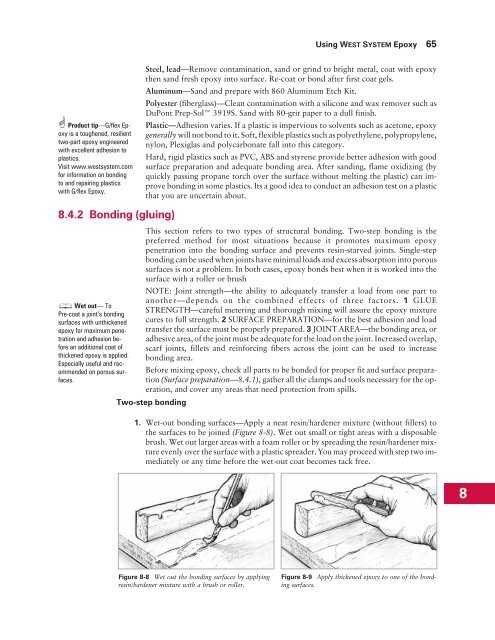Wooden Boat Restoration Repair - WEST SYSTEM Epoxy
Wooden Boat Restoration Repair - WEST SYSTEM Epoxy
Wooden Boat Restoration Repair - WEST SYSTEM Epoxy
Create successful ePaper yourself
Turn your PDF publications into a flip-book with our unique Google optimized e-Paper software.
Product tip—G/flex <strong>Epoxy</strong><br />
is a toughened, resilient<br />
two-part epoxy engineered<br />
with excellent adhesion to<br />
plastics.<br />
Visit www.westsystem.com<br />
for information on bonding<br />
to and repairing plastics<br />
with G/flex <strong>Epoxy</strong>.<br />
8.4.2 Bonding (gluing)<br />
Wet out—To<br />
Pre-coat a joint’s bonding<br />
surfaces with unthickened<br />
epoxy for maximum penetration<br />
and adhesion before<br />
an additional coat of<br />
thickened epoxy is applied.<br />
Especially useful and recommended<br />
on porous surfaces.<br />
Steel, lead—Remove contamination, sand or grind to bright metal, coat with epoxy<br />
then sand fresh epoxy into surface. Re-coat or bond after first coat gels.<br />
Aluminum—Sand and prepare with 860 Aluminum Etch Kit.<br />
Polyester (fiberglass)—Clean contamination with a silicone and wax remover such as<br />
DuPont Prep-Sol 3919S. Sand with 80-grit paper to a dull finish.<br />
Plastic—Adhesion varies. If a plastic is impervious to solvents such as acetone, epoxy<br />
generally will not bond to it. Soft, flexible plastics such as polyethylene, polypropylene,<br />
nylon, Plexiglas and polycarbonate fall into this category.<br />
Hard, rigid plastics such as PVC, ABS and styrene provide better adhesion with good<br />
surface preparation and adequate bonding area. After sanding, flame oxidizing (by<br />
quickly passing propane torch over the surface without melting the plastic) can improve<br />
bonding in some plastics. Its a good idea to conduct an adhesion test on a plastic<br />
that you are uncertain about.<br />
This section refers to two types of structural bonding. Two-step bonding is the<br />
preferred method for most situations because it promotes maximum epoxy<br />
penetration into the bonding surface and prevents resin-starved joints. Single-step<br />
bonding can be used when joints have minimal loads and excess absorption into porous<br />
surfaces is not a problem. In both cases, epoxy bonds best when it is worked into the<br />
surface with a roller or brush<br />
NOTE: Joint strength—the ability to adequately transfer a load from one part to<br />
another—depends on the combined effects of three factors. 1 GLUE<br />
STRENGTH—careful metering and thorough mixing will assure the epoxy mixture<br />
cures to full strength. 2 SURFACE PREPARATION—for the best adhesion and load<br />
transfer the surface must be properly prepared. 3 JOINT AREA—the bonding area, or<br />
adhesive area, of the joint must be adequate for the load on the joint. Increased overlap,<br />
scarf joints, fillets and reinforcing fibers across the joint can be used to increase<br />
bonding area.<br />
Before mixing epoxy, check all parts to be bonded for proper fit and surface preparation<br />
(Surface preparation—8.4.1), gather all the clamps and tools necessary for the operation,<br />
and cover any areas that need protection from spills.<br />
Two-step bonding<br />
Using <strong>WEST</strong> <strong>SYSTEM</strong> <strong>Epoxy</strong> 65<br />
1. Wet-out bonding surfaces—Apply a neat resin/hardener mixture (without fillers) to<br />
the surfaces to be joined (Figure 8-8). Wet out small or tight areas with a disposable<br />
brush. Wet out larger areas with a foam roller or by spreading the resin/hardener mixture<br />
evenly over the surface with a plastic spreader. You may proceed with step two immediately<br />
or any time before the wet-out coat becomes tack free.<br />
Figure 8-8 Wet out the bonding surfaces by applying<br />
resin/hardener mixture with a brush or roller.<br />
Figure 8-9 Apply thickened epoxy to one of the bonding<br />
surfaces.<br />
8
















